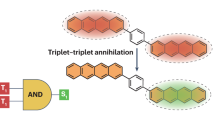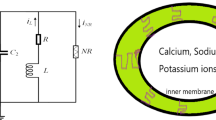Abstract
There are many ways in which a nonlinear chemical medium can be used for information processing. Here we are concerned with an excitable medium and the straightforward method of information coding: a single excitation pulse represents a bit of information and a group of excitations forms a message. Our attention is focused on a specific type of nonhomogeneous medium that has an intentionally introduced geometrical structure of regions characterized by different excitability levels. We show that in information processing applications the geometry plays an equally important role as the dynamics of the medium and allows one to construct devices that perform complex signal processing operations even for a relatively simple kinetics of the reactions involved. In the paper we review a number of published chemical realizations of simple information processing devices like logical gates or memory cells and we show that by combining these devices as building blocks the medium can perform complex operations like for example counting of arriving excitations. We also present a new, simple realizations of chemical signal diode that transmits pulses in one direction only.














Similar content being viewed by others
References
Adamatzky A, De Lacy Costello B et al (2005) Reaction-diffusion computers. Elsevier Science, Amsterdam
Agladze K, Aliev RR et al (1996) Chemical diode. J Phys Chem 100:13895–13897
Amemiya T, Ohmori T et al (2000) An Oregonator-class model for photoinduced behavior in the Ru(bpy)3 2+-catalyzed Belousov-Zhabotinsky reaction. J Phys Chem A 104:336–344
Armstrong GR, Taylor AF et al (2004) Modelling wave propagation across a series of gaps. Phys Chem Chem Phys 6:4677–4681
Calude CS, Paun G (2002) Computing with cells and atoms. Taylor and Francis, London
Dolnik M, Marek M (1991) Phase excitation curves in the model of forced excitable reaction system. J Phys Chem. 95:7267–7272
Dolnik M, Finkeova I et al (1989) Dynamics of forced excitable and oscillatory chemical-reaction systems. J Phys Chem 93:2764–2774
Dolnik M, Marek M et al (2002) Resonances in periodically forced excitable systems. J Phys Chem 96:3218–3224
Feynman RP, Allen RW, Heywould T (2000) Feynman lectures on computation. Perseus Books, New York
Field RJ, Noyes RM (1974) Oscillations in chemical systems. IV. Limit cycle behavior in a model of a real chemical reaction. J Chem Phys 60:1877–1884
Finkeova I, Dolnik M et al (1990) Excitable chemical reaction systems in a continuous stirred tank reactor. J Phys Chem 94:4110–4115
Gaspar V, Bazsa G et al (1983) The influence of visible light on the Belousov-Zhabotinskii oscillating reactions applying different catalysts. Z Phys Chem (Leipzig) 264:43–48
Gorecki J, Kawczynski AL (1996) Molecular dynamics simulations of a thermochemical system in bistable and excitable regimes. J Phys Chem 100:19371–19379
Gorecka J, Gorecki J (2003) T-shaped coincidence detector as a band filter of chemical signal frequency. Phys Rev E 67:067203
Gorecki J, Gorecka JN (2005) On mathematical description of information processing in chemical systems. In: Aiki T, Niezgodka M et al (eds) Mathematical approach to nonlinear phenomena; Modeling, analysis and simulations, vol 23. GAKUTO International Series, Mathematical Sciences and Applications, pp 73–90
Gorecka J, Gorecki J (2006) Multiargument logical operations performed with excitable chemical medium. J Chem Phys 124:084101
Gorecki J, Yoshikawa K et al (2003) On chemical reactors that can count. J Phys Chem A 107:1664–1669
Gorecki J, Gorecka JN et al (2005) Sensing the distance to a source of periodic oscillations in a nonlinear chemical medium with the output information coded in frequency of excitation pulses. Phys Rev E 72:046201
Gorecka J, Gorecki J et al (2007) One dimensional chemical signal diode constructed with two non-excitable barriers. J Phys Chem A 111:885–889
Haken H (2002) Brain dynamics. Springer, Berlin
Kapral R, Showalter K (1995) Chemical waves and patterns. Kluwer, Dordrecht
Krischer K, Eiswirth M et al (1992) Oscillatory CO oxidation on Pt(110): modeling of temporal self-organization. J Chem Phys 96:9161–9172
Krug HJ, Pohlmann L et al (1990) Analysis of the modified complete Oregonator accounting for oxygen sensitivity and photosensitivity of Belousov–Zhabotinskii systems. J Phys Chem 94:4862–4866
Kuhnert L, Agladze KI et al (1989) Image processing using light-sensitive chemical waves. Nature 337:244–247
Kuramoto Y (1984) Chemical oscillations, waves, and turbulence. Springer-Verlag, Berlin
Lazar A, Noszticzius Z et al (1995) Chemical pulses in modified membranes I. Developing the technique. Physica D 84:112–119
Mikhailov AS, Showalter K (2006) Control of waves, patterns and turbulence in chemical systems. Phys Rep 425:79–194
Motoike I, Yoshikawa K (1999) Information operations with an excitable field. Phys Rev E 59:5354–5360
Motoike IN, Yoshikawa K et al (2001) Real-time memory on an excitable field. Phys Rev 63:036220
Murray JD (1989) Mathematical biology. Springer-Verlag, Berlin
Noszticzuis Z, Horsthemke W et al (1987) Sustained chemical pulses in an annular gel reactor: a chemical pinwheel. Nature 329:619–620
Rambidi NG, Maximychev AV (1997) towards a biomolecular computer. information processing capabilities of biomolecular nonlinear dynamic media. BioSystems 41:195–211
Sielewiesiuk J, Gorecki J (2001a) Chemical impulses in the perpendicular junction of two channels. Acta Phys Pol B 32:1589–1603
Sielewiesiuk J, Gorecki J (2001b) Logical functions of a cross junction of excitable chemical media. J Phys Chem A 105:8189–8195
Sielewiesiuk J, Gorecki J (2002a) On complex transformations of chemical signals passing through a passive barrier. Phys Rev E 66, 016212
Sielewiesiuk J, Gorecki J (2002b) Passive barrier as a transformer of chemical signal frequency. J Phys Chem A 106:4068–4076
Steinbock O, Toth A et al (1995) Navigating complex labyrinths—optimal paths from chemical waves. Science 267:868–871
Suzuki K, Yoshinobu T et al (2000) Unidirectional propagation of chemical waves through microgaps between zones with different excitability. J Phys Chem A 104:6602–6608
Tanaka M, Nagahara H et al (2007) Survival versus collapse: abrupt drop of excitability kills the traveling pulse, while gradual change results in adaptation. Phys Rev E 76:016205
Taylor AF, Armstrong GR et al (2003) Propagation of chemical waves across inexcitable gaps. Phys Chem Chem Phys 5:3928–3932
Tero A, Kobayashi R et al (2006) Physarum solver: a biologically inspired method of road-network navigation. Physica A 363:115–119
Toth A, Horvath D et al (2001) Unidirectional wave propagation in one spatial dimension. Chem Phys Lett 345:471–474
Volford A, Simon PL et al (1999) Rotating chemical waves: theory and experiments. Physica A 274:30–49
Author information
Authors and Affiliations
Corresponding author
Rights and permissions
About this article
Cite this article
Gorecki, J., Gorecka, J.N. & Igarashi, Y. Information processing with structured excitable medium. Nat Comput 8, 473–492 (2009). https://doi.org/10.1007/s11047-009-9119-y
Published:
Issue Date:
DOI: https://doi.org/10.1007/s11047-009-9119-y




